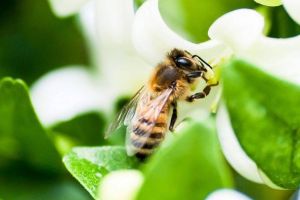it looks like the interior of any new, still-empty condo development. The ceiling is white. The walls are a neutral gray. It has yet to be staged, save for a lone Dyson fan that whirs in the middle of the room.
Synthetic Apiary from Mediated Matter Group on Vimeo.
You’re looking at a home designed just for bees. Developed by MIT’s Mediated Matter Group, which focuses on nature-inspired design and fabrication, the Synthetic Apiary is both a research facility and an architectural intervention in a natural world where our pollinating friends are struggling to survive.
The world is getting less and less habitable for bees. While three quarters of the world's crops are pollinated by species like bees, global bee populations are but half what they were in 1945. In fact, for the first time in history, several bee species have been added to the U.S. endangered species list.
"Our goal is to create a new artificial habitat for bees, not simply introduce them into our own," writes the Mediated Matter Group via email. "Habitat loss is one of the main reasons for the declining population—the Synthetic Apiary is our response to that fact. It is made for bees, for them to rebuild, flourish, and thrive."
The key word is "artificial." While apiaries are all manmade and can scale the size of greenhouses, they traditionally allow bees to come and go. MIT's apiary is completely sealed, meaning that bees can’t fly in and out to feed on real-world flowers before coming home for the night. The Synthetic Apiary is essentially a place where bees are raised in complete, protective captivity.
As such, the space has been carefully designed both for bee study and for their long-term health. The white and gray walls are not a coincidence. They make it easy to photograph and examine bee behaviors—a species that flies up to seven miles in the wild daily.
"Currently, most field studies face the challenge that bees are not easily trackable and can traverse great distances, so non-hive-based behaviors are very difficult to observe," the team explains. "This is a novel space that can allow for more true laboratory style observation and experimentation, so we . . . could more easily understand what causes individual and hive behaviors and events."
Mark Wilson 10.10.16 7:00 AM




